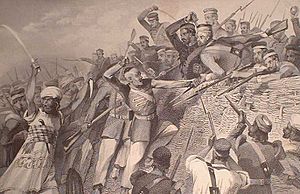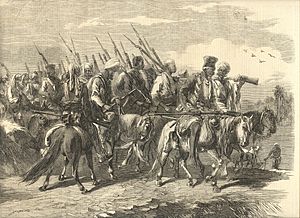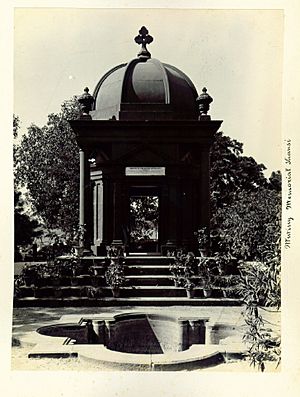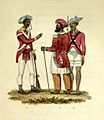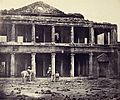Indian Rebellion of 1857 facts for kids
Quick facts for kids Indian Rebellion of 1857 |
|||||||||
|---|---|---|---|---|---|---|---|---|---|
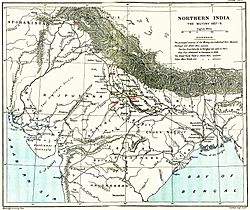 A 1912 map of 'Northern India: the Revolt of 1857-58' showing the centres of rebellion including the principal ones: Meerut, Delhi, Cawnpore (Kanpur), Lucknow, Jhansi, and Gwalior |
|||||||||
|
|||||||||
The Indian Rebellion of 1857 was a big uprising against British rule in India. It is also known as the Indian Mutiny or India's First War of Independence. The rebellion started on May 10, 1857. It began when Indian soldiers, called Sepoys, working for the British East India Company's army, rebelled. These sepoys in the Bengal region turned against their British officers.
Contents
Why the Rebellion Started
The reasons for the rebellion are complex and have been debated a lot. Before the rebellion, there were about 50,000 British soldiers. There were also 300,000 Indian sepoys.
Growing Unhappiness
The British Indian army was split into three main groups. These were the Bombay, Madras, and Bengal armies. The soldiers in these armies came from different parts of India.
The Bengal Army mostly recruited soldiers from higher castes. These included Rajputs and Bhumihars. In 1855, they stopped recruiting as many lower-caste people. The Madras and Bombay armies were different. They recruited soldiers from all castes. Many people believe that having so many high-caste soldiers in the Bengal Army led to the first revolts.
Some changes to the soldiers' jobs also caused anger. As the East India Company grew, soldiers had to serve in new places. For example, they had to go to Burma. They also stopped getting extra pay for serving in foreign lands. Another money problem was a new rule about pensions. This rule meant new soldiers would not get a pension when they retired. Older soldiers worried this rule would apply to them too. Also, the Bengal Army was paid less than the other armies. This made their fears about pensions even worse.
The Spark that Started It All
The immediate cause of the rebellion was about new rifles and their cartridges. Soldiers had to bite open the cartridges to load their rifles. Muslim soldiers became angry because they thought the cartridges had pig fat on them. Muslims believe pigs are unclean. Hindu soldiers were also angry because they believed the cartridges had cow fat. Cows are sacred to Hindus.
On January 27, Colonel Richard Birch ordered that no cartridges should have grease. He said sepoys could grease them with whatever they wanted. However, this only made the soldiers believe the stories about pig and cow fat were true.
During the 1850s, the British rulers also took over more Indian regions by force. For example, the kingdom of Agra and Oudh was seized in 1856. This was against Hindu traditions. The British did not respect old Indian royal families. This included the Mughals and the Peshwas.
Key Events
The rebellion began when a soldier named Mangal Pandey attacked a British sergeant. He also wounded an officer in Barrackpore. General Hearsey ordered another Indian soldier to arrest Mangal Pandey, but he refused. Later, the British arrested both Mangal Pandey and the other soldier. The British hanged them for what they saw as treachery. All other soldiers in that group lost their jobs in the army.
On May 10, 1857, cavalry troops at Meerut broke ranks during a parade. They freed the soldiers of the 3rd regiment. Then, they marched towards Delhi. Soon, many Indians in north India joined these soldiers. They entered the Delhi Fort, where Bahadur Shah II, the Mughal Emperor, lived. They asked him to lead the rebellion. He agreed, even though he was unwilling.
Very quickly, the revolt spread across north India. Important Indian leaders from royal families joined the rebellion. They started fighting the British in many places. These leaders included:
- Ahmed Ullah, an advisor to the former King of Oudh.
- Nana Sahib, his nephew Rao Saheb, and his helpers, Tatya Tope and Azimullah Khan.
- The Rani of Jhansi.
- Kunwar Singh, a Rajput chief from Jagadishpur in Bihar.
- Firuz Saha, a relative of the Mughal Emperor, Bahadur Shah.
At first, the British were slow to react. But then they acted very quickly with strong forces. They brought soldiers from the Crimean War to India. They also sent many regiments that were going to China to India instead.
The British forces reached Delhi. They surrounded the city from July 1 to August 31, 1857. Eventually, street-to-street fights broke out between the British and Indian troops. The British finally took control of Delhi.
Other important events included the massacre at Kanpur in July 1857. There was also the siege of Lucknow, which lasted from June to November 1857. The last major battle was at Gwalior in June 1858. The Rani of Jhansi was killed there. A few days later, the British recaptured the fortress of Gwalior. With this, the British had mostly stopped the rebellion. However, some small-scale fighting continued until early 1859. Tatya Tope was captured and executed in April 1859.
British Response
The rebellion was a very important event in the history of modern India. In November 1858, the Parliament of the United Kingdom took away the British East India Company's right to rule India. The United Kingdom began ruling India directly. Their representative was called the Governor General. India became part of the British Empire.
The British promised "the Princes, Chiefs, and People of India" equal treatment under British law. In 1877, Queen Victoria took the title of Empress of India. The Viceroy of India ruled India for her.
The British sent Bahadur Shah II, the last Mughal Emperor, out of India. They kept him in Yangon (then called Rangoon), Burma. He died there in 1862. The Mughal dynasty, which had ruled India for about four hundred years, ended with his death.
The British also took steps to include higher-caste Indians and rulers in the government. They started hiring Indians in civil services, but at lower levels. They stopped taking the lands of the remaining Indian princes and rulers. They also stopped interfering in religious matters. They increased the number of British soldiers. Only British soldiers were allowed to handle artillery. Some Indian troops were executed by being shot from the mouth of cannons.
Opinions on the Rebellion
In England, newspapers focused on the violence of the rebellion. Some of the reports were not completely true. Charles Dickens wrote that the English should get revenge. He wrote about this in his 1857 novella The Perils of Certain English Prisoners.
Timeline of Events
- 1857
- May: The revolt begins on May 10 in Meerut. It quickly spreads to Delhi and other cities. Many Indian soldiers are disarmed.
- June: More mutinies happen across India. The siege of Europeans in Kanpur and Lucknow begins. British forces start operations against Delhi.
- July: Mutinies continue. The siege of Lucknow continues. British forces try to relieve Kanpur.
- August: The rebellion spreads to more areas. Disarming of Indian units continues.
- September: The British capture Delhi after heavy fighting. The Lucknow residency is relieved, but a new siege begins.
- October: More unrest and mutinies occur in various states.
- November: Sir Colin Campbell relieves Lucknow. British forces are defeated outside Kanpur.
- December: A decisive battle at Kanpur takes place. The armies of Rao Sahib and Tatya Tope are defeated.
- 1858
- January: General Sir Hugh Rose begins a campaign in Central India. Sir Colin Campbell starts to recapture Lucknow.
- February: Saugor is relieved. Campbell's army prepares to recapture Lucknow.
- March: Lucknow is recaptured on March 21. The Central India campaign continues.
- April: The city of Jhansi is captured. The British advance on Kalpi. Campbell begins to reconquer Rohilkhand.
- May: Bareilly is recaptured. Kalpi is reoccupied. Rebels start a guerrilla war.
- June: Tatya Tope and the Rani of Jhansi seize Gwalior. British forces recapture Gwalior after battles. Guerrilla forces are suppressed in many areas.
- July to December: Most remaining guerrilla forces are suppressed.
- 1859
- April: Tatya Tope, the last captured rebel leader, is tried and executed on April 18. This marks the end of the Indian Rebellion of 1857.
Images for kids
-
An 1858 photograph by Felice Beato of a mosque in Meerut where some of the rebel soldiers may have prayed
-
The Flagstaff Tower, Delhi, where the British survivors of the rebellion gathered on 11 May 1857; photographed by Felice Beato
-
A wood-engraving of Nynee Tal (today Nainital) and accompanying story in the Illustrated London News, 15 August 1857, describing how the resort town in the Himalayas served as a refuge for British families escaping from the rebellion of 1857 in Delhi and Meerut.
-
Capture of Bahadur Shah Zafar and his sons by William Hodson at Humayun's tomb on 20 September 1857
-
A memorial erected (circa 1860) by the British after the Mutiny at the Bibighar Well. After India's Independence the statue was moved to the All Souls Memorial Church, Cawnpore. Albumen silver print by Samuel Bourne, 1860
-
The interior of the Secundra Bagh, several months after its storming during the second relief of Lucknow. Albumen silver print by Felice Beato, 1858
-
Jhansi Fort, which was taken over by rebel forces, and subsequently defended against British recapture by the Rani of Jhansi
-
Marble Lectern in memory of 35 British soldiers in Jhelum
-
Lieutenant William Alexander Kerr, 24th Bombay Native Infantry, near Kolapore, July 1857
-
The Relief of Lucknow by Thomas Jones Barker
-
Bahadur Shah Zafar (the last Mughal emperor) in Delhi, awaiting trial by the British for his role in the Uprising. Photograph by Robert Tytler and Charles Shepherd, May 1858
-
The proclamation to the "Princes, Chiefs, and People of India," issued by Queen Victoria on 1 November 1858. "We hold ourselves bound to the natives of our Indian territories by the same obligation of duty which bind us to all our other subjects." (p. 2)
-
Memorial inside the York Minster
-
Suppression of the Indian Revolt by the English, which depicts the execution of mutineers by blowing from a gun by the British, a painting by Vasily Vereshchagin c. 1884. Note: This painting was allegedly bought by the British crown and possibly destroyed (current whereabouts unknown). It anachronistically depicts the events of 1857 with soldiers wearing (then current) uniforms of the late 19th century.
-
Charles Canning, the Governor-General of India during the rebellion.
-
Lord Dalhousie, the Governor-General of India from 1848 to 1856, who devised the Doctrine of Lapse.
-
Lakshmibai, the Rani of Maratha-ruled Jhansi, one of the principal leaders of the rebellion who earlier had lost her kingdom as a result of the Doctrine of Lapse.
-
Bahadur Shah Zafar, the last Mughal Emperor, crowned Emperor of India, by the Indian troops, he was deposed by the British, and died in exile in Burma
-
The Bibighar Well site where a memorial had been built. Samuel Bourne, 1860.
See also
 In Spanish: Rebelión de la India de 1857 para niños
In Spanish: Rebelión de la India de 1857 para niños


